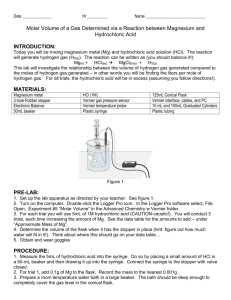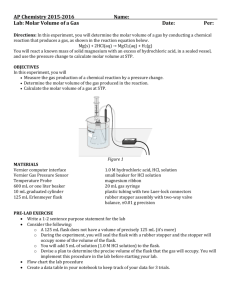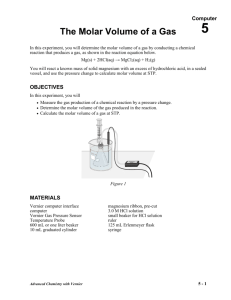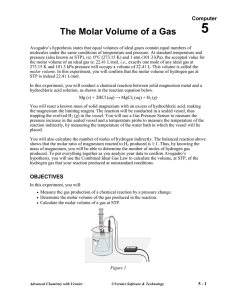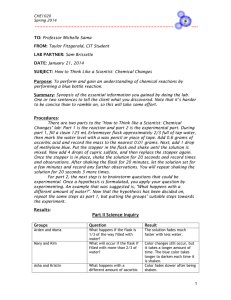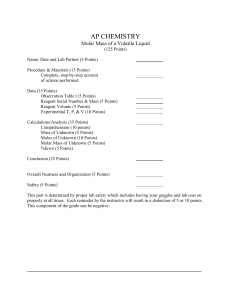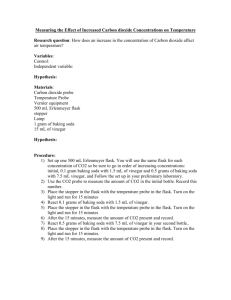The Molar Volume of a Gas
advertisement
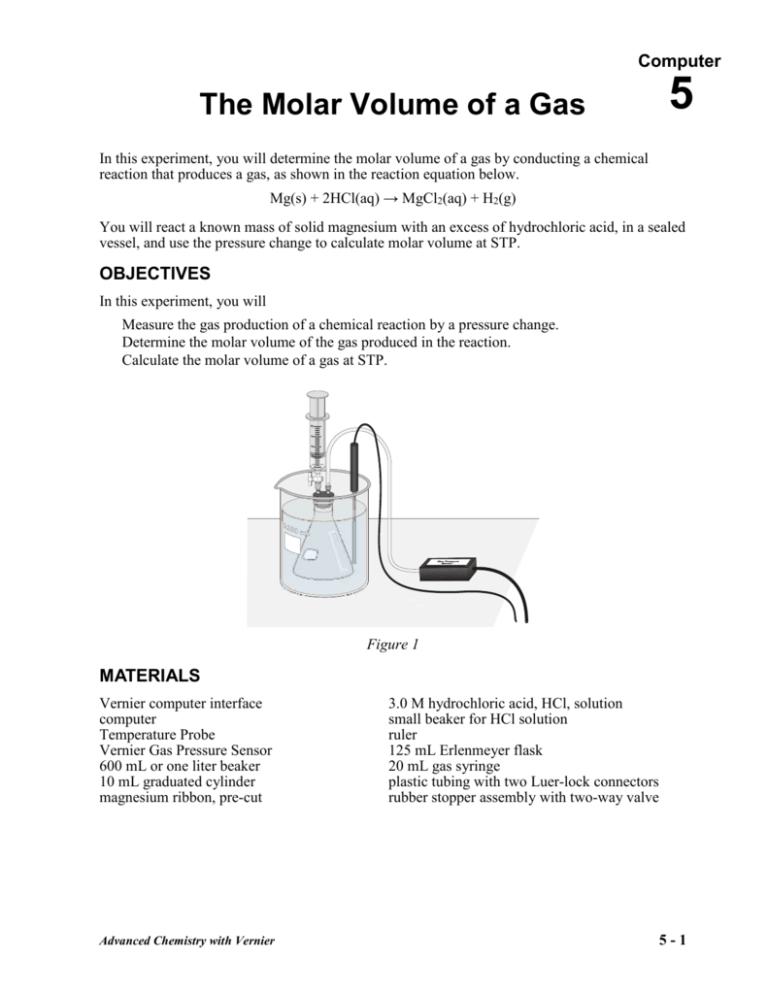
Computer The Molar Volume of a Gas 5 In this experiment, you will determine the molar volume of a gas by conducting a chemical reaction that produces a gas, as shown in the reaction equation below. Mg(s) + 2HCl(aq) → MgCl2(aq) + H2(g) You will react a known mass of solid magnesium with an excess of hydrochloric acid, in a sealed vessel, and use the pressure change to calculate molar volume at STP. OBJECTIVES In this experiment, you will Measure the gas production of a chemical reaction by a pressure change. Determine the molar volume of the gas produced in the reaction. Calculate the molar volume of a gas at STP. Figure 1 MATERIALS Vernier computer interface computer Temperature Probe Vernier Gas Pressure Sensor 600 mL or one liter beaker 10 mL graduated cylinder magnesium ribbon, pre-cut Advanced Chemistry with Vernier 3.0 M hydrochloric acid, HCl, solution small beaker for HCl solution ruler 125 mL Erlenmeyer flask 20 mL gas syringe plastic tubing with two Luer-lock connectors rubber stopper assembly with two-way valve 5-1 The Molar Volume of a Gas PRE-LAB EXERCISE Obtain the 125 mL Erlenmeyer flask that you will use for the experiment. Determine and record the available volume of the flask that the hydrogen gas will occupy as it is produced from the reaction of the solid magnesium and the hydrochloric acid solution. Account for the following items when you determine the volume of your flask: A 125 mL flask does not have a volume of precisely 125 mL. During the experiment, you will seal the flask with a rubber stopper and the stopper will occupy some of the volume of the flask. You will add 5 mL of solution (3.0 M HCl solution) to the flask. PROCEDURE 1. Obtain and wear goggles. 2. Mass about 0.1 g of magnesium ribbon. Record its mass exactly. DO NOT USE MORE THAN 0.1 g OF MAGNESIUM. Place the piece of magnesium ribbon in a clean and dry 125 mL Erlenmeyer flask. 3. Prepare a room temperature water bath in a large 600 mL beaker. The bath should be deep enough to completely cover the gas level in the Erlenmeyer flask. 4. Set up the Pressure Sensor (Channel 1) and Temperature Probe (Channel 2). Connect the Lab Pro to the computer and plug it into an electrical outlet. 5. Use the clear tubing to connect the white rubber stopper to the Pressure Sensor. (About onehalf turn of the fittings will secure the tubing tightly.) Twist the white stopper snugly into the neck of the Erlenmeyer flask to avoid losing any of the hydrogen gas that will be produced in the reaction (see Figure 1). Important: Close the valve on the white stopper by turning the white handle so it is perpendicular with the valve stem. 6. Obtain a small amount of 3.0 M hydrochloric acid. CAUTION: Handle the hydrochloric acid with care. It can cause painful burns if it comes in contact with the skin. Draw 5 mL of HCl solution into the 20 mL syringe. Thread the syringe onto the two-way valve on the white stopper (see Figure 1). Submerge the Erlenmeyer flask into the water bath. Position the Temperature Probe in the water bath so that the tip of the probe is not touching the beaker. 7. Start the Logger Pro program on your computer. From the Advanced Chemistry with Vernier folder, open experiment 5 (Molar Volume). Under the data menu, choose column options pressure. Change the pressure units to atm. 8. With the flask still submerged in the water bath, click Collect to begin data collection. After about 20 seconds, open the two-way valve directly below the syringe, press the plunger to add all of the 5 mL of HCl solution to the flask, and close the two-way valve. 9. Gently swirl the flask, while keeping it immersed in the water bath, as the reaction proceeds. Data collection will stop after 5 minutes. During the experiment, only the pressure readings will be plotted on the graph. You may click Stop to end data collection before 5 minutes have elapsed, if the pressure readings are no longer changing. 10. Carefully remove the white stopper from the flask to relieve the pressure in the flask. Important: Do not open the two-way valve to release the pressure in the flask. Advanced Chemistry with Vernier 5-2 The Molar Volume of a Gas 11. Examine the pressure data to determine the change in pressure, P, during the reaction. In addition, determine the average temperature of the water bath during the reaction. Record these values in your data table. 12. Rinse, clean, and dry the flask for a second trial. Obtain a new piece of magnesium ribbon, mass it, and place it in the flask. Repeat the necessary steps to conduct the second trial. Note: 13. Follow the same procedure to conduct a third trial. 14. Use your text, or another appropriate reference, to find and record the water vapor pressure for the temperature of each trial. CALCULATIONS (Show one sample calculation for each part. Place all answers in table below.) 1. Calculate the number of moles of each piece of magnesium used in trials 1, 2, and 3. 2. Calculate the change in pressure due to hydrogen gas in trials 1, 2, and 3 using Dalton’s law. 3. Calculate the volume of the hydrogen gas at STP using the combined gas law. 4. Using the balanced chemical equation and the moles of magnesium used, calculate the moles of hydrogen gas formed. 5. Find the molar volume by dividing the volume of the gas (#3) by the moles of hydrogen formed (#4). 6. Compare the calculated molar volume, at STP, with the accepted molar volume of an ideal gas at STP, 22.4 L/mol. Complete a percent error calculation. Comment on the % error calculation and suggest possible sources of experimental error in the error analysis section. Advanced Chemistry with Vernier 5-3 The Molar Volume of a Gas DATA TABLE Trial 1 Trial 2 Trial 3 Trial 1 Trial 2 Trial 3 Mass of Mg Volume of flask (L) Maximum pressure (atm) Initial pressure (atm) Pressure change, ∆P (atm) Temperature (K) Vapor pressure of water (atm) Calculations Table Moles of Mg (mol) Pressure due to H2 (atm) Volume of H2 at STP (L) Moles of H2 (mol) Molar volume of H2 at STP (L) Average molar volume of H2 at STP (L) Percent error Advanced Chemistry with Vernier 5-4

